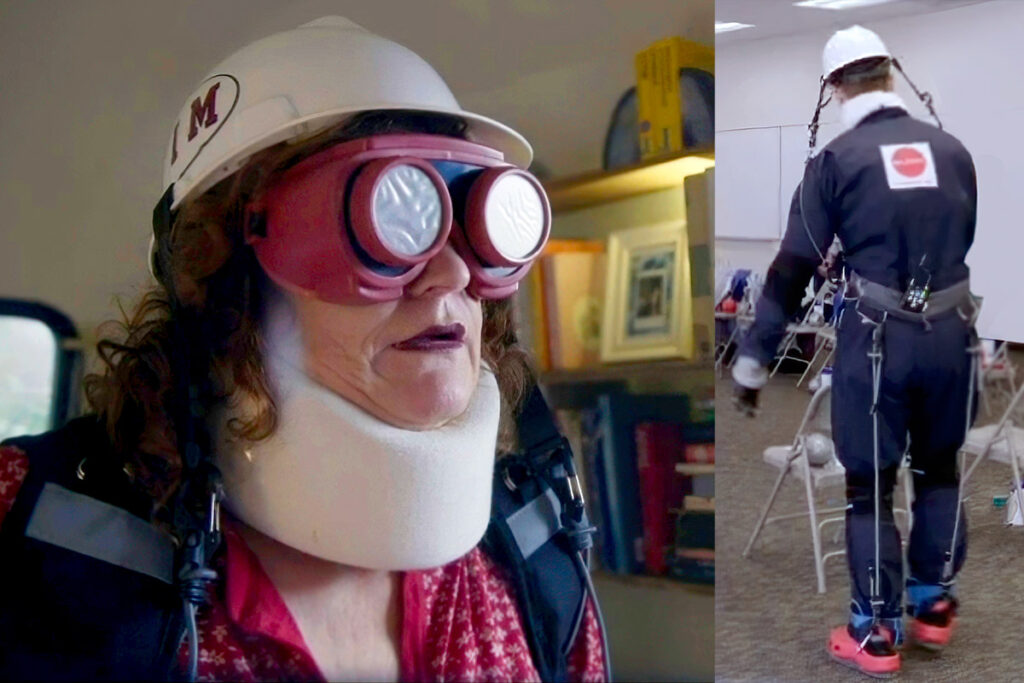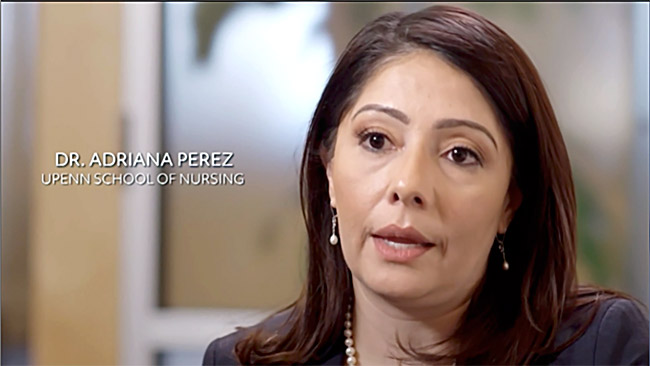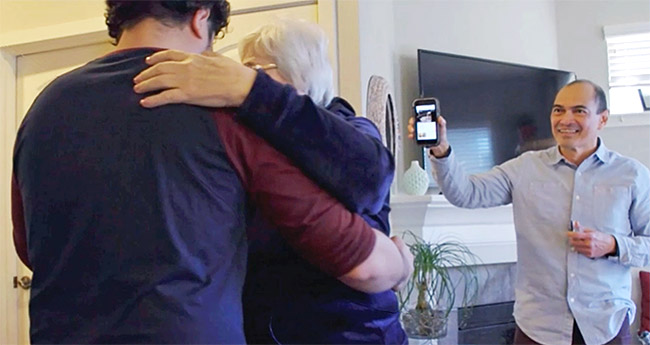Improving Care for Older Adults
News
Penn LDI’s Adriana Perez in PBS Documentary on Aging and Health
Educating with Technology that Ages a Person 30 Years in One Day

Wearing the MIT AgeLab “empathy suit,” participants in the PBS “Fast-Forward” documentary experience what it’s like to be a frail 85-year-old.
If you’re making a health-related educational TV documentary you hope will stick in the minds of your audience, it helps to have some dramatic visual element that expresses the whole message without saying a word. The spectacularly memorable one used in the just-released PBS show Fast-Forward was the MIT AgeLab‘s “empathy suit,” or AGNES — Age Gain Now Empathy System. It uses a tangle of contraptions to encase a young person in all the physical infirmities typically found in 85-year-olds. Even the goggles that give it such a distinctively bizarre air are designed to produce the effects of diabetic retinopathy, tunnel vision, and weakened visual acuity.
Infirmity simulation apparatus
Originally created for consumer product developers, engineers and architects trying to understand the subtleties of elders’ daily experiences, the AGNES suit includes a helmet and strap assembly to stiffen the neck, a thick brace to further reduce neck flexibility, assemblies of weights and bungee devices to reduce overall limb flexibility and endurance, gloves that lessen sense of touch and dexterity, and rubbery shoes with built-in elements that constantly threaten a person’s balance.
“It certainly does look strange and is a real attention getter,” said Adriana Perez, LDI Senior Fellow and Assistant Professor in the University of Pennsylvania School of Nursing, “but it’s not something for use in therapy. In this film, it’s designed to educate younger people about the often non-obvious aspects of aging that can have a major impact on the health and wellness of their parents and, eventually, themselves.”
Researching aging Latino Populations
Perez, PhD, ANP-BC, FAAN, past Chair of the Expert Panel on Aging at the American Academy of Nursing, joined other gerontological experts from MIT and Harvard in the hour-long PBS program to provide an overview of the aging issues most Americans — young and old — fail to recognize or address. She is also a scholar and RCMAR Scientist in Penn’s Center for Improving Care Delivery for the Aging (CICADA). Her research is focused on the health-related role of physical activity, neighborhood environment, and social support in aging in Latino communities.

The documentary follows father-son and mother-daughter pairs from four families in Pennsylvania, Louisiana, Idaho, and Oregon as they go through a week of exercises that demonstrate the realities of aging, as well as various ways to plan and achieve a healthier and more satisfying older life.
The PBS project was commissioned by the John A. Hartford Foundation as part of its larger national programs of education and support for the improvement of elder health and health care. The Gordon and Betty Moore Foundation was also a sponsor of the project.
One of the country’s larger private philanthropic organizations focused on health care, the 92-year-old Hartford Foundation’s stated mission is to “invest in aging experts and practice innovations that transform how the care of older adults is delivered.” One of the emerging academic talents it invested in 10 years ago was Adriana Perez, providing the funding for her pre- and post-doctoral training.
Personal impact
“Aside from being part of the film, I was moved by its overarching message that had a personal effect on me,” said Perez. “My sisters and I were thinking and talking about it this morning. Our mother is very young, in her 60s, but the film caused us to think ahead more specifically about her future in a way we hadn’t really done before.”
“Another issue the film really emphasized,” Perez said, “is that the U.S. population is generally not well prepared for planning and managing its move into old age, even though 10,000 people turn 65 every day,” she continued. “One recent study I conducted involved 40 older Latino adults — none had ever had a conversation with their family about end-of-life wishes. I think those of us in research and heath care need to do more to provide the knowledge and tools that facilitate these conversations as the film suggests.”
Both the Hartford and Moore Foundations have aggressive plans for disseminating the documentary, which is available for free viewing on the PBS site, to educators and local and regional organizations involved in senior care. On the flip side of its somber topic of end-of-life plans, the documentary stresses ways families can better organize and plan support and care for their elder members. A companion website offers courses and a comprehensive master checklist on how to plan for your own, or a loved-one’s, elder years.
Encouraging geriatics students
“Fast-Forward is a great tool for those teaching about aging,” said Perez. “I’ve already sent it around to many colleagues. Normally, students studying aging are exposed to a lot of information about illness and death and often develop a view on aging that is not positive. The film sheds light on the positive aspects of aging in a way that may help encourage more students to pursue geriatrics.”
Perez pointed out the Fast-Forward project doesn’t end with this first documentary; there are plans to produce shorter programs on other aspects of aging.
“They filmed many, many hours of material, most of which didn’t make it into the final one-hour cut that was about the physical aspects of aging,” said Perez. “It doesn’t give you much of a glimpse into the mental, social, or emotional aspects of aging as well as other issues. It’s important to point out that the four families in the film had access to experts. The reality is that not all families with an aging adult have that, and not all providers are specialized in the care of older adults.”
“In my full interview,” Perez continued, “I talked a lot about health equity and my research with vulnerable populations that experience aging in a much different way for lack of resources. Many lack health care coverage, or they’re immigrants who have worked their whole life in an essential job, so their aging and their life expectancy is a lot different. So, hopefully, there will be some additions to the film’s website that do touch on the inequities some older adults experience.”
Health impact of isolation
The film pointed out that while the AGNES suit’s physical restrictions were obvious, its socially isolating effects were less so, even though prolonged loneliness is a major health risk for older adults.
A National Institute for Health Care Management Foundation (NIHCM) report in 2018 found that isolation “raises the risk of premature death as much as smoking or obesity. In addition, an estimated $6.7 billion in annual federal spending is attributable to social isolation among older adults. The impact on the health system and public health is only anticipated to increase with the growing aging population.”
According to the U.S. Health Resources & Services Administration, prolonged isolation in old age is more damaging to health than smoking 15 cigarettes a day. And an AARP survey found that Latinos are more likely than non-Latinos to mistakenly believe that loneliness is a normal part of aging and that married people “can’t be lonely.”
“While elder isolation is a well-documented issue,” said Perez, “what we’re seeing within the context of the COVID-19 epidemic underscores its harmful impact on older adults with chronic conditions.”
Compounded in minority populations
“What I’ve seen in my own experience as a nurse practitioner and a researcher,” she continued, “is that isolation also brings a lot of emotional costs to both the separated family and the isolated older adult. Most of the patients and study participants I work with live with intergenerational families. On one hand, that’s a positive thing because there’s a lot of support there. But on the other hand, within the pandemic context, it’s not possible to socially isolate. This is part of the problems compounded among older Black, Latino and other minority populations.”
The Penn Nursing research team that Perez heads has just received a $3.1 million, four-year National Institute of Aging grant to explore how to promote physical activity, cardiovascular health, cognitive health, and sleep in older Latinos with mild cognitive impairment. The study will compare intervention costs to health care utilization costs to assess future sustainability. It notes, “Latinos are often identified as one of the most sedentary of the older racial/ethnic groups and experience significant multi-level barriers to physical activity — including cost, environmental/neighborhood and safety concerns, and lack of social networks.”
Music as medicine
One of the most poignant scenes in Fast-Forward involved the use of music as an element of therapy for elders with mild cognitive impairments – a population that Perez studies.

The grandmother of the Oregon Fast-Forward family met with Todd Lawrence of Music and Memory, a local program that uses iPods filled with playlists of music from a dementia patient’s younger life to spark memories and social engagement. The 79-year-old woman spent her early years in Buenos Aires, Argentina, where she was an avid dancer and loved tango and flamenco music.
Her family members explained she had become increasing reclusive and quiet as her condition progressed. After he got her talking about those days of music and dancing, he coaxed her to sing part of what used to be one of her favorite songs — “Buenos Aires, When Will I See You Again?” While softly mouthing the song, the woman’s face lit up and she began smiling, clapping her hands, and encouraging her family members to join in.
“There’s a lot more research that shows that music interventions help preserve our memory as we age,” explained Perez. “Music serves as a point of interaction, where we talk about what that song meant and the memories that song elicits. Music can be a medicine just as physical activity can be a medicine, and many people often underestimate the power of the arts in keeping older adults healthy and happy — and as suddenly joyful and engaged as this patient in Oregon.”
The therapist later brought out the iPod, playing other period songs of the grandmother’s Argentinian youth and, to the amazement of her family, she got up and began dancing. They alternately cried and laughed.